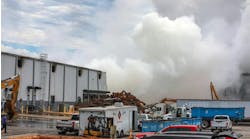Avoid Issues in Process Safety Management Compliance
A 1984 event shattered any concepts of how much tragedy could occur from a single industrial incident such as a chemical leak. Until then, most Americans probably never had heard of the city of Bhopal, India. However, a leak in December of that year became known forever simply as the Bhopal Disaster. Approximately 45 tons of dangerous methyl isocyanate gas escaped from an insecticide plant and spread airborne to heavily populated areas; thousands were killed and countless others suffered health effects. (For more details on the tragedy, see: “Grasp All the Lessons of Bhopal,” and for a safety expert’s take on what the Bhopal Disaster taught that industry still sometimes forgets, see the late Trevor Kletz’s article “Bhopal Leaves a Lasting Legacy.”)
Bhopal had a major impact on current and future generations in the United States through the Process Safety Management (PSM) regulation set forth by the U.S. Occupational Safety and Health Administration (OSHA).
Simply stated, its purpose is to regulate highly hazardous chemicals (HHCs) to reduce the possibility of or completely prevent such a major chemical-related incident from occurring again. OSHA Standard 29 CFR 1910.119 focuses strictly on potentially lethal HHCs, not low-risk releases.
In addition, the U.S. Environmental Protection Agency (EPA) created a Risk Management Program (RMP) as part of the Clean Air Act in response to major chemical accidents in Bhopal and Institute, West Virginia.
OSHA promulgated its final PSM standard on February 24, 1992, and the EPA issued its RMP rule on June 20, 1996. (The EPA has just proposed amendments to the accidental release prevention requirements. See: “EPA Eyes Risk Management Program.”)
Both OSHA and the EPA essentially were on the same track in moving to protect plant workers and the public from HHC releases. The EPA’s RMP has four sections: offsite consequence analysis, where companies must outline worst-case scenarios; five-year accident history (detailing only the most serious accidents); prevention program (similar to OSHA’s PSM); and emergency response program. Many facilities mistakenly think EPA and OSHA prevention programs are the same. However, OSHA’s PSM remains the driving force in preventing or mitigating high-risk chemical release incidents. As stated by OSHA: “The main purpose of PSM of hazardous chemicals is to prevent unwanted releases of hazardous chemicals, especially [where] employees and others [could be exposed] to serious hazards. An effective PSM program requires a systematic approach to evaluating the whole chemical process.” The single overriding point is that a facility can’t exceed a threshold of certain chemicals found on OSHA’s HHC list.
Key Elements Of Compliance
The first step in a PSM program is properly understanding its fourteen essential components — because compliance isn’t a brief a-b-c exercise but may pose quite a few challenges. According to OSHA, all the elements are interlinked and interdependent.
In brief, the 14 components are:
- Compiling adequate process safety information. This requires developing and maintaining written safety materials identifying workplace, processes and equipment issues.
- Conducting a process hazard analysis. The assessment may include pinpointing potential accidental release sources, determining the location of previous releases that could have become catastrophic, and estimating effects of such releases.
- Consulting with employees about assessments and chemical accident prevention plans and providing appropriate access to these materials.
- Setting up a system to respond to workplace hazard-assessment findings.
- Reviewing the workplace hazard and response system.
- Developing written procedures for the chemical processes, including procedures for each operating phase, operating limitations and safety/health considerations.
- Providing written safety/operating information and training for employees.
- Giving contractors and contract employees appropriate information and training.
- Educating and training employees and contractors in emergency response procedures.
- Establishing a quality assurance program to ensure that initial process-related equipment, maintenance materials and spare parts are fabricated and installed consistent with design specifications.
- Creating maintenance systems for critical process-related equipment to ensure ongoing mechanical integrity.
- Performing pre-startup safety reviews of all newly installed or modified equipment.
- Putting in place written procedures for change management relative to process chemicals, technology, equipment and facilities.
- Investigating every incident resulting in, or that could have resulted in, a major accident and reviewing findings for modifications they may suggest.
- Because OSHA’s PSM program deals with such a serious issue, HHCs, the penalties for non-compliance can be steep. Companies may incur fines of up to $500,000 and individuals may get hit with fines of up to $250,000 for wide-ranging non-compliance, including reportable releases, injuries and even simply not meeting paperwork requirements. Additionally, they may face civil lawsuits and, in a worst-case scenario, a company may be forced to shut down.
Given the complexities involved, companies can’t address compliance simply on an ad-hoc or low-priority basis but instead should develop a risk mitigation program to satisfy OSHA’s PSM.
OSHA stresses that companies can’t meet compliance standards on a shoestring budget and should allocate approximately 3% of gross revenue to the task. OSHA actually affords companies some flexibility in spending. Over a five-year period, large companies should spend 1.1% of their gross revenue and small companies 3.2%. These aren’t rigid figures but underscore that compliance should not be unbudgeted or have an unrealistically low budget.
Every company subject to PSM should designate a suitable individual to be in charge during the entire compliance process. Typically, most companies lack a “glove fit” employee but, at chemical companies, the person chosen preferably should be an engineer, ideally one specializing in mechanical integrity. If a company doesn’t have an appropriate individual, a common-sense approach is to retain a PSM engineering consultant with at least five years of experience. The consultant may continue on a permanent basis or temporarily until the company can fill the position internally.
Finally, a crucial element in every PSM compliance process is developing a cost-effective and reasonable plan for accomplishing the goals. Success is “all in the details.” Companies find that a well-managed, highly functional program more than meets expectations for being in compliance and avoiding penalties. In other words, effective management is the key to compliance.
Common Mistakes
The road to compliance can lead to many potential wrong turns. Indeed, companies make a number of common mistakes. Let’s look at six and how to remedy them.
• Believing training of everyone is the all-purpose answer. It’s not. After training, companies must effectively police the system to help ensure that all the compliance efforts are proceeding as intended.
• Over-emphasizing efficiency. Too many projects appear to fly through hazard and operability (HAZOP) reviews but don’t work once they are completed. Focus on the details and take the time to do the job right.
• Taking the attitude that “anything within the fence line is considered by the company to be part of PSM.” Although an interesting concept, it can create problems. Once such a policy is formally stated, regulatory inspectors must accept the policy at face value, which may be to the company’s detriment. Re-evaluate what actually applies to PSM.
• Failing to consider the Facility Car Seal Program. This mandates that all pressure valves must be car sealed open as part of PSM. Realistically, to be effective a car seal program must be regularly verified, documented and audited. Consider any car seal found broken, or any safety-critical manual valve found in an improper position, as a PSM “near miss.”
• Not performing mechanical integrity inspections on schedule. Many people clearly understand the potential negative consequences but delays still happen all too often. Audits usually reveal that a percentage of pressure vessel, tank, instrument and rotating equipment inspections are overdue. Companies should recognize this reality and take the appropriate action. When an inspection must be postponed, initiate a management-of-change procedure to determine what, if any, additional safeguards are required until the delayed inspection occurs. If overdue inspections are a continuing problem, perform a formal root cause analysis to determine why.
• Paying inadequate attention to competency standards. These are expressed in terms of outcome, and specify both the knowledge/skill necessary and its appropriate application for adequate performance in the workplace. When properly addressed, competency assurance can lead to significant improvements and ensure requirements are met. For more on this topic, check out “Discover the Benefits of a Competency-Based Approach,” http://goo.gl/DeL9fs.
A Recent Wrinkle
As sometimes occurs with major regulations, details get fine-tuned or substantially revised over time. Between the mid-1990s and 2007, the PSM program spurred improvements but some catastrophic incidents still occurred. So, OSHA decided to revise the PSM National Emphasis Program (NEP).
In 2011 a new Chemical NEP went into effect following the success of a pilot program for the petroleum industry that was implemented in 2007. Identified as OSHA Instruction CPL 03-00-14, PSM Covered Chemical Facilities National Emphasis Program, it generally is called CHEMNEP. The NEP for refineries and CHEMNEP, which are similar but not identical programs, both involve an in-depth look at the now well-known fourteen major elements.
As a whole, CHEMNEP’s intent is to conduct focused inspections at randomly selected facilities nationwide, chosen from a listing of workplaces that likely have covered processes. Because the pilot CHEMNEP uncovered many problems similar to those discovered in the Petroleum NEP, OSHA expanded the program nationally both to increase awareness of dangers and push employers more forcefully toward preventing HHC releases.
The “top ten” points to know about the new CHEMNEP for chemical plant operators, in no ranking order, are:
• It became effective immediately with no expiration date.
• CHEMNEP now encompasses all OSHA regions. Unlike the pilot programs, chemical plant operators must participate.
• Targets include types of workplaces similar to those in the pilot that had submitted Program 3 Risk Management Plans to the EPA, have an NAICS code for explosives manufacturing, are in OSHA’s database for being cited previously for PSM issues, and are known to be operating a PSM-covered process.
• In determining what to inspect, OSHA will select the “most hazardous process” based on several factors, including age, chemical quantity in the process, how many workers and contractors are present, ongoing maintenance, and incident or “near miss” reports.
• Each OSHA office nationally must complete 3–5 programmed CHEMNEP inspections annually — one must relate to ammonia refrigeration and the rest to “other” PSM-covered processes.
• OSHA stresses that implementation outweighs documentation.
• The new CHEMNEP features dynamic list questions, which rotate from time to time and aren’t disclosed publicly.
• Employers must produce multiple types of documents, including a listing of PSM-covered processes, itemization of the plant’s units and maximum-intended inventories, three years of OSHA 300 logs, summary description of the company’s PSM program, details about process and safety systems, and PSM incident reports for selected units.
• Even a single issue potentially may yield multiple citations. For example, one valve change could impact eleven different elements.
• Abatement verification and documentation now are mandatory, unlike in the pilot NEP.
Embrace PSM Compliance
The very concept of regulation, especially in the industrial sector, typically engenders only grudging compliance out of necessity and threats of penalties. Yet, few events galvanize such support for change and regulation as did the Bhopal and Institute tragedies’ heavy loss of life and widespread non-fatal injuries. So, although OSHA’s PSM doesn’t garner universal acclaim, the chemical industry and other industries with potential for major HHC incidents largely support it.
Likewise, while critics may complain that any regulation is too complicated or distracts too much from work devoted to profitability, the general consensus on PSM is that continuing to do “business as usual” puts employees and the public at needless risk from HHCs, and a new direction had to be taken because the issue is just too important. Following the PSM regulations can be done sensibly, either internally or by calling in outside experts.
ADAM JACKSON is vice president, engineering and technical services, for ACS Engineering, Houston. E-mail him at [email protected].


